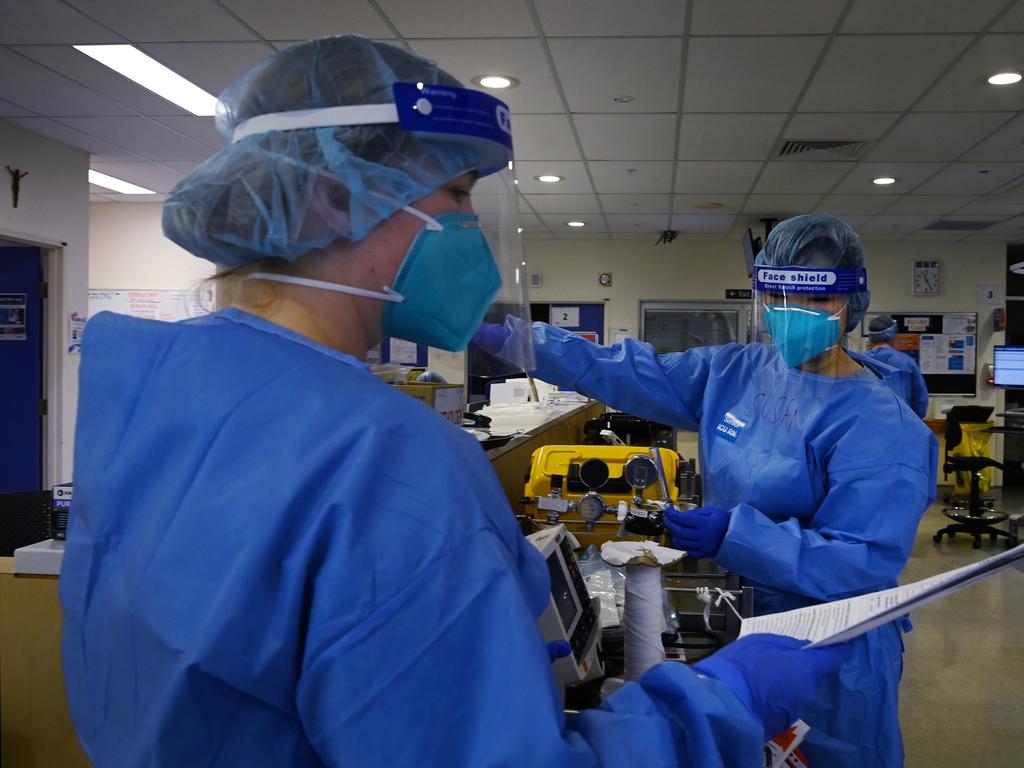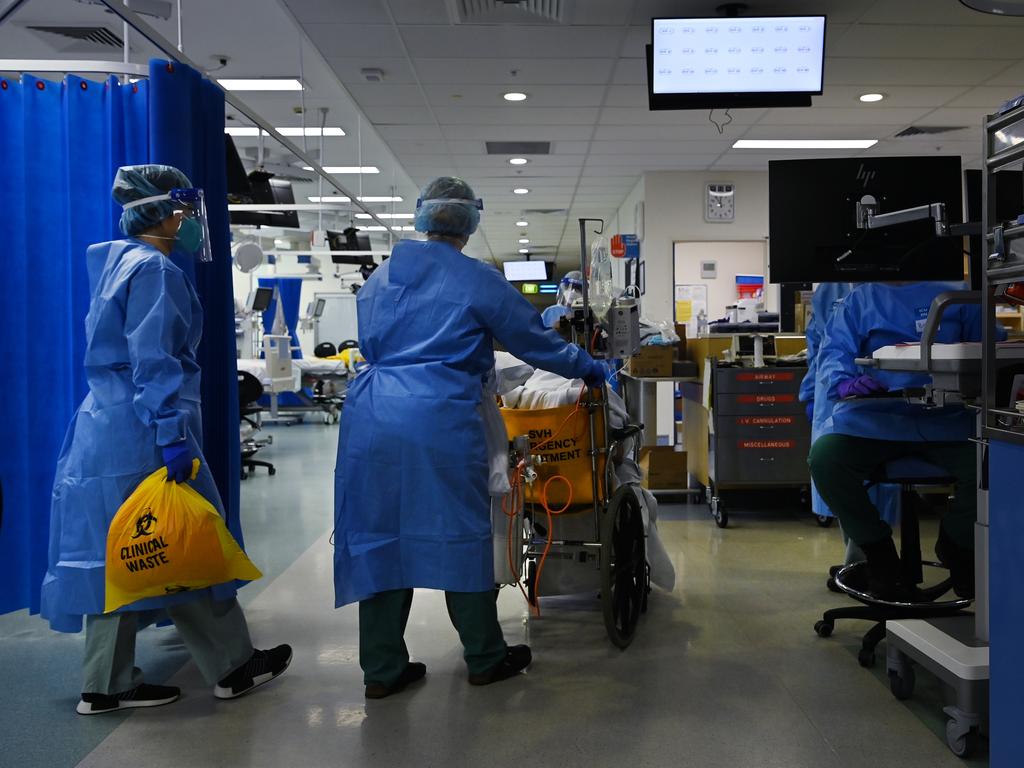New ICU guidelines detail ‘ethical challenges’ around those ‘most likely to survive’
Intensive care doctors, struggling under the dozens of Covid patients in ICU, have been issued new guidelines to prepare them for an onslaught of sick people.
Intensive care doctors in NSW have been issued new guidelines outlining the “ethical challenges” they could face in coming weeks if forced to limit lifesaving ventilators to Covid-19 patients “who are the most likely to survive”.
The new guidelines prepared by NSW Health have outlined the life and death decisions that could emerge and guidelines for doctors on how to triage cases based on the “probability of survival.”
To prepare for the onslaught, NSW hospitals have paused elective surgery with anaesthetists undergoing emergency training to be sent onto the Covid frontline.
Speaking on the condition of anonymity to news.com.au, a Sydney-based ICU specialist said the new advice underlined the grim choices that doctors could be facing.
“It says that triage may need to be considered and if patients are not going to make it, you should expedite at the end of life conversations,” he said.
“None of us want to get to that stage, but that is actually in the document.
“I guess the best analogy is what we do with organ transplants because there are a limited number of organs and far more potential recipients. So we have organs and so we try to ensure that a scarce resource, in that case it would be intensive care, goes to the person who has the best chance of surviving.”

The official advice for ICU doctors in NSW warns a triage system may be required in coming months.
“During a pandemic it will be important that consistent decisions are made regarding both admission to ICU and continuing care when a meaningful recovery is unlikely,” the official advice states.
“The process of triaging intensive care resources includes both the process of allocating resources and the process of withdrawal of resources, for all patients that may require intensive care during a respiratory pandemic.”
The term “withdrawal of resources” refers to taking Covid patients off ventilators if they are unlikely to survive to free up a bed for a patient that can be saved.
“Complex ethical and clinical treatment issues can occur, it may be necessary at some point to begin prioritising limited critical care resources to those with a need for treatment and those who are most likely to survive,” the advice states.
“Such prioritisation decisions would need to take into account all patients’ probability of survival, as well as the availability of limited critical care resources.”
Despite NSW Premier Gladys Berejiklian predicting there was capacity to cope with the surge, the ICU doctor who spoke to news.com.au said health workers on the frontline were worried.
“If something keeps going up, without stopping, it’s going to overwhelm any system in the world. Queensland is looking at whether they can free up staff to send down, they don’t think it’s going to go well in New South Wales,” he said.
“If we have a surge, we’ve got like a four stage plan. The final stage is like, you know the whole ICU that becomes a Covid ICU, But that would be catastrophic, because then we couldn’t do any of the other work.”
There are currently 150 patients in NSW ICU units. Of those patients 127 are unvaccinated. There are more than 900 Covid patients in the hospital.
There are currently 917 COVID-19 cases admitted to hospital, with 150 people in intensive care, 66 of whom require ventilation.
— NSW Health (@NSWHealth) September 1, 2021
There were 173,913 COVID-19 tests reported to 8pm last night, compared with the previous day’s total of 130,027.

The number of Covid patients on ventilators currently stands at 66 people and the death toll of the current outbreak stands at 100.
As cases surge in NSW, data analysts predict cases could hit 3000 a day or 20,000 a week in late September. But the real surge in ICU is expected in October.
“There‘s a big disconnect between what’s being said publicly and what is happening on the frontline already,” the ICU doctor said.
“Because the reality is the system is already not doing what it‘s meant to do. We’ve had to cancel scheduled heart surgery and other major surgery for patients.”
In terms of triaging patients, the ICU doctor said specialists were already talking about what happens when the hospital hits capacity.
“NSW Health Minister Brad Hazzard has been saying we have quadrupled the ICU capacity. That is just not accurate. More recently he said we have quadrupled the number of ventilators. Those two things are very different issues,” he said.
“I’ve never actually seen one of these ‘quadrupled ventilators’ at the frontline. I’ve got no idea if these surge ventilators are up to modern standards or not because I have never seen them.
“People are pretty angry that you know their family members who are not vaccinated. There were two young people who died early. Both caught Covid from being a household contact with a health care worker.”
The NSW guidelines for pandemic resource-based decision are designed to ensure that NSW ICU services are supported to provide consistent care in a way that suits current epidemiological and clinical conditions.
The guideline was developed by intensive care clinical experts and ethicists in consultation with NSW Covid-19 Critical Intelligence Unit (CIU) and the NSW Health Ethics Advisory Panel (HEAP).
Each hospital is being asked to take an inventory of the following resources to inform their local critical care surge response.
• Available ICU beds and additional non-commissioned ICU bed spaces.
• Potential suitable bed spaces in non-intensive care areas which may be used for intensive care
patients, e.g. recovery, perioperative units, respiratory units, and CCUs.
• Negative pressure isolation rooms.
• Non-pressurised isolation rooms.
• Check with engineering regarding airconditioning flows in negative pressure rooms and
single rooms.
• Equipment and consumables required to set-up and sustain a typical ICU bed space.
• Standard ICU ventilators.
• Other ventilation devices including transport ventilators and those located outside the ICU,
e.g. OT, emergency department (ED).
• Portable monitoring devices including portable oxygen saturation monitors, inside the ICU and in other clinical areas.
• Availability of personal protective equipment (PPE).




